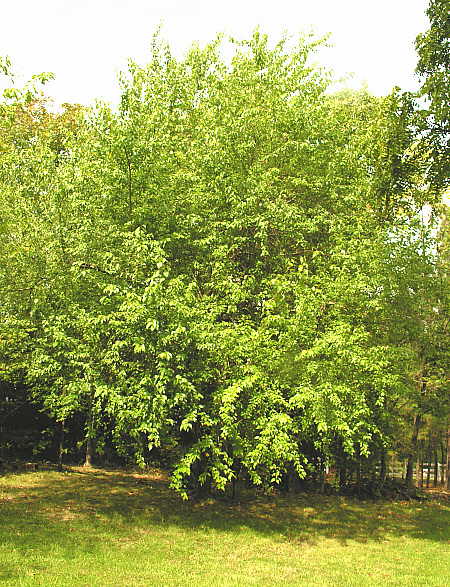
This is a tree with various names. Some refer to it as the bois d’arc (pronounced “bodark”), which is french for “bow wood.”  It is also referred to as an Osage orange tree, hedge apple tree, and horse apple tree. All of these monikers have a basis in the properties of the tree, as we shall see in the following paragraphs. Some people dislike these trees, while others adore them, depending upon their perspectives.
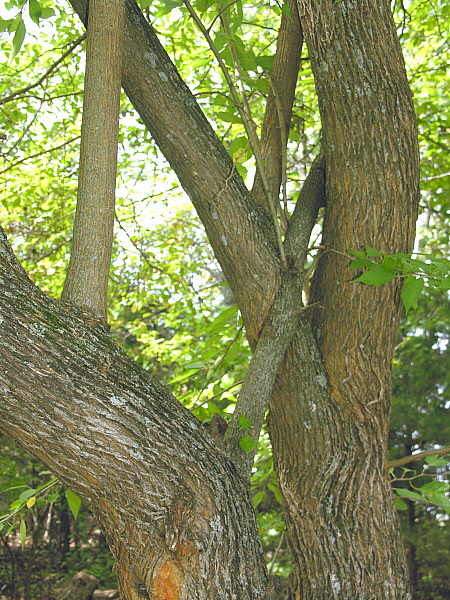
The picture above is a trunk of a bois d’arc tree. The wood of this tree is extremely hard and tough, which makes it a sought after tree for cutting into fence posts. But if you intend to cut one of these trees, you had better arm yourself with plenty of sharp chains on your chainsaw, as the tough, yellowish wood of the bois d’arc will dull the chain rapidly. It is also advisable to wear long sleeves made of thick fabric, as the spines on the branches can cause painful lacerations if you are not careful.
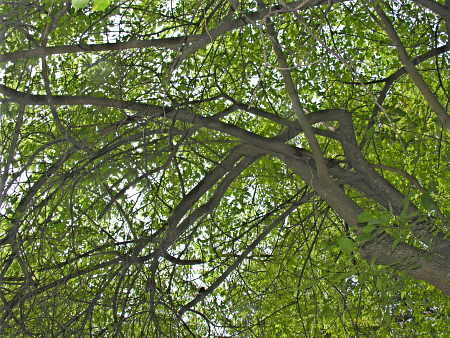
The canopy of the bois d’arc forms a tangled mass of branches, which are armed with stout, flesh-piercing barbs. Because of the dense mass of resilient, barbed and tough wood that the tree produces, it was planted with tight spacing as a hedge row in times prior to the invention of barbed wire. It is referred to as being “horse high, bull strong, and hog tight,” an ideal specification for a farmstead hedge row. Because of the toughness and decay resistance of the wood, combined with the long, straight, resilient branches that this tree produces, it was prized as a source of wood in which to construct bows in the past, hence it’s name bois d’arc tree, or bow wood tree.
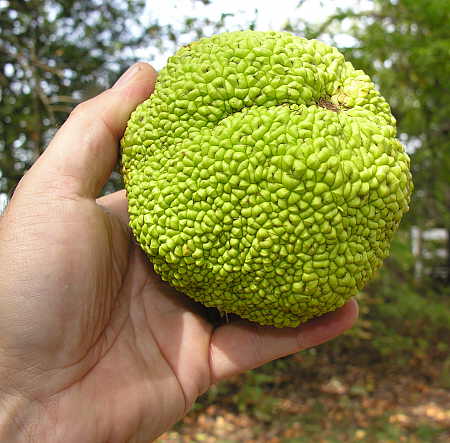
This is the fruit produced by the bois d’arc. Some call this the Osage orange, possibly because the skin emits a citrus-like scent when it begins to rot. Because the trees were often grown as a hedge, the fruit has been called a “hedge apple” by some. Because the fruit is consumed by horses, it is termed a “horse apple” by others. Osage orange, hedge apple, or horse apple, it remains that humans do not consume this fruit. But, as just mentioned, horses eat the fruit of the bois d’arc tree, as well as squirrels and cattle.
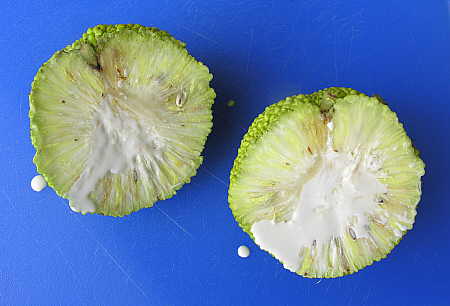
If you slice the fruit in half, which requires a stout knife, as the fruit is quit hard until it begins to rot, you will find that after a minute or two the fruit begins to “weep”, as you can see in the photograph above. Only the female tree produces the fruit, which propagates the tree through the germination of the approximately 200 seeds contained within the fruit. In the fall, the fruit begins to drop from the limbs of the tree, and when they do, watch out, as it hurts to be struck by the falling, heavy, hard fruit of the Osage orange, or bois d’arc tree.



“Some people dislike these trees, while others adore them, depending upon their perspectives.”
Well, don’t leave us hanging … which one are you?
David – There is only one tree that I do not like, and I dislike it with a passion. It is the honey locust, which has the most wicked thorns you can imagine. The following link has a photograph of the 6″ spines on the locust:
http://www.mitzenmacher.net/blog/?p=24
I’ve always wondered how it is that I find these trees randomly on the tops of hills in the forest. If the fruit falls, it isn’t going to roll up hill. I suppose squirrels.
We still have “fence rows” composed of Osage Orange or Ironwood Hedge as we sometimes call it. But those are few and far between these days. You might not believe it but there is actually a market for Hedgeballs and typically they sell four for a dollar at the local farmer’s market. Many people claim they have insect repellant properties and I remember my mom scattering them in the corners of our old farm house. My recollection says that we still had plenty of crickets and boxelder bugs around.
I have some friends up in Wisconsin who are chainsaw dealers and one evening I was telling them that Osage Orange is the hardest tree I know. They were bragging that their specialty chains could cut through anything so I took them out to a fence row and let them have at it. They both had dull blades before getting tree chopped up. They were so amazed, that they loaded up their truck with the pieces and took it back to their store to show the public up there.
I hate the honey locust because I’m forever getting flat tires due to their thorns but I kind of like the Osage Orange tree. Their drooping branches create great wildlife shelter for deer and pheasants for fifteen or twenty feet on either side of the “fence row”. We just let that area under the trees grow up in grass and farm outside of the “fence row.” Because it is denser, it does a much better job of breaking the wind and snows.
Great post. I’ve never seen one in real life. They must not grow here.
Ed – thanks for the information. I forgot to mention the insect repellent properties that the fruit is supposed to have. Googling this quickly reveals that there is almost a “cult-like” following pertaining to the qualities of the Osage orange fruit. I haven’t tried using them around the house for this purpose. When I pick up the fallen fruit, I usually have to brush off a few insects from the surface. So much for insect repellency!
FC – Thanks. We don’t have palms up here in the Ozarks, so I guess we’re even.
Hal, do you just mow over them like I do?
Duane, I only have two bois d’arc trees in my yard area, and one of them is a non-fruit bearing male. There are so few fruits that fall from the female that I just pick them up and toss them into a nearby pasture.
Have you ever tried making a bow from them? Now that I know that they were favored to make bows, I just may have to try that the next time I go down to the farm.
Ed – Back in the days when I was learning about such things as bow making, I lived in Southern California, which is not a habitat for the bois d’arc tree. Instead, the Native Americans in that area relied on the willow as a source for straight, limber bow wood. I have made bows with willow, but not bois d’arc.
I don’t know if you’ve ever burnt this wood, but I would suggest extreme caution when doing so. This wood will make a woodburning stove glow cherry red and will drive most people from a room or a tent. One piece is plenty. I’m not sure if there have been any studies done as to the output of heat from various woods but, to the best of my knowledge, this one takes the cake. The wood is very dense and stores an immense amount of energy.
I have been making dreamcatchers and walking sticks out of some peeled roots that were dug up in my yard and was looking for edible/medicinal qualities of the root because they smell good. I tried the apple insect repellant theory twenty years ago…it doesn’t work for roaches. I do know that you can grow other trees on them. I have seen 5 kinds of pear branches grow on one bois d’arc tree.
Thanks so much for the great article praising the Rusty Wheels Club. Our group Of men and women are trying to keep part of the past alive for the next generation. Thanks again, Bill
This is incredible. One of our parishioners just discovered that we have this tree growing at the edge of our property line. When she showed me the fruit today and asked me what it was, I said it “looks like a brain.” I could not believe it was real. I thought it was something that had come from the children’s play room.
Yes, it was cut up…and it did “bleed.”
Now I am interested in learning two things…1. is the tree procurable as seedlings; I was thinking of growing a hedgerow of sorts along part of my property line – we live on a rock-laden mountain in northern Virginia; and 2. would the limbs, after being cured, serve as good walking sticks.
Any feedback would be appreciated. Thanks. fr n
Fr. Trevino – Bois D’Arc seedlings are available from the following website (as well as others)-
http://www.musserforests.com/prod.asp?p=OSO
I would imagine the Bois D’Arc would make excellent walking sticks, aside from the fact that the wood is very heavy.
i live on a farm and my barn and garages were being over run by spiders. an old farmer told me to cut a few of these in half and leave them laying about and it will rid my spider problems. i had nothing to lose, so i tried it. i was amazed… within a week i couldnt even find a spider… i guess that is why we are taught to respect our elders, they been there and done that.
Are there any medicinal recipes that are known to exist that use the fruit of the bois d arc? If so is there a website that I can access to learn about theses recipes. Thanks…Bill B
Bill – I’m sorry, but I do not have the answer to either of your questions.
I don’t know of any either but I do have a quesion. I live in South West France and have been given a young plant for my garden. Where should I plant it – how big does it get, are the roots a menace…I am American but come from Michigan originally and have never seen these trees before.
Thanks!
I’ve discovered a bois d’arc tree near my house and the “apples” are beautiful. Can these be dried or somehow preserved for use in floral arrangements? My father says they “stink” when they start to rot. How soon do they rot? I’d like to use them in arrangements, but I don’t want something ‘stinky” in my house. Any information or link would be appreciated.
we have these trees in Oklhoma. I have several growing on our cattle pasture just northwest of Oklahoma City. I’ve never really inspected them before besides just shooting the fruit out of the tree with a shotgun! I’ll take a close look at it next time I’m out there.
I am actually looking for some saplings of this type of tree. Do you know where I can get them from? I use them in wood turning projects with my lathe. When the wood is machined the grain of the wood is beautiful. I am on the Mississippi Gulf Coast.
Steve
Steve – Seedlings are available here –
http://www.musserforests.com/prod.asp?p=OSO
In response to the question of “have you ever tried to make bows out of them”, I can answer DEFINITELY. Osage makes some of the most beautiful bows as well as the most functional and powerful. I in fact teach a class several times a year on native bowmaking and we use strictly osage staves: http://www.adventureout.com/advanced_skills.html
It doesn’t take much to get these trees to grow. I have cut small limbs from these and just planted them and they grew. Take the fruits and cut them up and plant them. That’s how we did fence rows years ago. They will grow in just about any soil types and conditions. Fruits will not dry to use in flower arrangements, they usually just start rotting after a while.
These trees can get huge and are very dense. Another woodturner and I have just aquired a huge one, the base is over 36 inches in diameter. We had to get a semi-truck to hall it home for us.
Now that I am a woodturner I love these trees now to make turned items to sale. When I go do a show, I have always been asked if I have any thing made from bois d’arc. I wear a respirator when I turn this wood. You have to let this wood dry before you turn it because it has a tendency to split.
Today I was at a lawn and garden show in Ft Smith, Arkansas and a gentlemen there had some trees for sale and he said he had a new bois d’arc tree that was thornless and fruitless. He sold limbs by the foot. So I bought a couple of limbs to plant. This should be interesting to see how they do.
Does repell spiders and some insects.
I have some of the Honey Locust trees on my property. I have also had a forester draw out a Stewardship Plan for the state. He referred to them as “Thorny Locusts” My parents when alive had a Honey Locust that had the pods but no thorns. We try to eliminate these when we find them but some of the DNR’S biologists are asking to save them as a bird known as a type of Shrike that impales cartured mice on the thorns for later. We care for animals but I also care for my grandchildren and myself. We eithe frill them or doulble ring them w/ a chain saw and later drop and burn when dry. If you google the name there is instance’s of biblical meaning to some re; the thorns.
Thanks for reading
We are fortunate to have both the osage orange and the locust trees on our 2 acre lot in central Ohio. We have to cut most of them down in order to make the property liveable and house worthy. We still have about 15 of the osage and about 6 or the locust, this is not counting all the little saplings growing all around the house.
I do like the shade that these trees give off and the “protection” aspect of the locust tree. The deer in our rural area eat the hedge apples and that is what is what germinates these seed to produce more and more of these trees. We also have the fence post made out of them. I have read that the osage wood has a higher BTU than coal. I can atest to the hardness of this wood. If you cut some down you better split it right away or forget it. We have made mailbox holders out of some of the limbs. The roots do go on forever for one tree. If you cut the tree at the stump you will have many new growths within a 2 month period.
It is amazing that the locust tree can produce such sharp thorns and when they are growing are like rubber but once they dry out watch out. We always said that if anyone tries to come on the property without our permission the trees will take care of them before the dogs can get to them. The property was part of a 200 acre cattle farm. These trees are all over the old farm. So many people do not believe us when we talk about our “thorn” trees until they see pictures.
These trees have thorns but are very different from the Honey Locust. The Trunk and branches of the bodarc make excellent fence posts which never rot in your lifetime. The Honey Locust are the ones that have the thorns all over the trunk and limbs which make them undesireable to have on your place. They are the main reason I have had tractor tire flats.
I’ve got about 20 saplings which I grew from seeds I harvested from fruit sent me by my Dad. Nobody wants them because of their thorns. If you are in the Lafayette, LA area, I’ll be happy to let you have some.
I am so surprised to read of the affection of these trees…we live on about 120 acres in rural Oklahoma and have found these thorn trees and b’darcs to be a nuisance…if you have enough mmmf about you to actually cut down the bodarc then they grown back with a vengence and bring their friends toboot…in other words…where you had one,,,all of a sudden you may will have 3 growing in its place…we were told to treat the stump with som poison…but are very scared to deal with such things…anyone have any ides on how to wipe these pesky trees from your land?
We live in Missouri and I have battled thorny locust and Hedge trees our whole life. Hedge makes great fence posts and firewood (be careful BTUs higher than any other tree I know of, similar to coal). Love it im my outdoor wood stove. Cannot find any good use for honey locust except for fire wood. It has a pretty high btu also but nothing like hedge. As far as killing these trees we use a product called Torodon btu. After you cut a tree down you put a small amount along where the bark meets the interior of the tree all the way around the stump (we have tried sprays but the stump treament works the best. This product works extremly well on both of these trees. If you do not treat them when you cut them you are just componding your problem as both trees have large energy souces in the roots and will send up numerous shots when cut. if you have a large number of them a tree shear and a person on the ground treating the stumps is the only way to go. And cut the ones that seed first. No reason to go after the males till the females are gone.
I spent the weekend cutting hedge for fence post and i got to worrying that some of it wasn’t actually hedge because it is fall here and no hedge apples. I’ve since learned that only the females produce the apples. This makes me feel more confident that what I cut was male hedge. The other thing that I noticed was that it seems that the male trees also are without thorns. Does anybody know if that is right or have I mistakenly cut some other type of tree down that really looked like hedge.
Recently we cleared off some land we had purchased about three years ago and lo and behold there is the biggest bois d’arc tree(we have always called them horse apple trees)I have ever seen. The base of the tree takes three adults with arms drapped around, touching fingers to encircle. I would guess its at least 30, could be 40 feet tall. On one huge limb I plan on putting a swing as I know that limb would never break. I have tried to find out if this tree could be a record of some kind, but can’t find any info. We live in the most northern edge of Collin County, in Texas. I thought it was very interesting to find out from reading all the comments above of the things people make out of the tree.
MY SON SENT ME THIS ARTICLE FROM JAPAN, THERE ARE SOME OF THESE TREES ACROSS THE STREET FROM MY HOME. WHEN WE WERE GROWING UP WE CALLED THE FRUIT “MONKEY BRAINS”. WE USED TO BOWL WITH THE FRUIT. WE WOULD ROLL IT DOWN THE SIDE STREET TO THE MAIN HIGHWAY. THEY WOULD THEN GET SQUISHED.
Bois d’arc is so dense that it will not float in water. Not many woods can do that.
I found this very informing. We bought a home in west Texas and have the darndest tree growing here. It has thorns on the linbs quite a few of them. Since it is now leafed out I see fruit similiar to mulberry but it is not turning color just green. We bought this home several years ago I have asked folks if they know what it is. No one seems to know. After readin your article I think it may be the bois d’ arc.
Pingback: Words from my reading « Word Lily
Hello,
Does anyone know where I can find some branch or limb that are 2 inch thick or larger in the oasge orange or the Maclura Pomifera. I needing several for my birds.
The fruit is a great organic way of keeping the roaches and probably other creepy crawlies out of your home. Only use the fruit from the tree in the early fall, place fruit on a bag/paper towel/etc and stash under your sinks and other places that may provide a water source for the creepy crawlers. The creepy crawlies hate this because the fruit contains boric acid! The fruit will rot over time however it is odorless.
If you do end up picking fruit off the ground you are taking a risk that it has already started rotting…which will draw in more bugs.
Enjoy your free orgainic roach repelant!
We have these trees on our propperty and have used the apples for years when the crickets seem to take over. Yes, they do rot and you don’t want to leave them in a corner of the room for too long. I have a question, though. About 2 months ago, I stepped on one of the thorns and it went through my thick-soled shoe, into the ball of my foot. It was more than an inch long. I soaked my foot in Epsom salts for several days but it is still painful to walk on, even after these 2 months. Someone told me that they contain a poison. Is this true? Has anyone else had a similar experience?
please where can i buy some im from california?
email me at princessliuz@yahoo.com
Jan, I do believe the thorn has the boric acidic qualities you use the fruit for crickets , spiders repellant:, my father stepped on one while looking for me as a child and it took several months too, make sure the tip is out, reopen wound, irrigate with Iodine solution,Epson salts again (antibiotic cream) If you catch it early you can put a cut potato on it for hours at a time and it’s supposed to remove toxin, hope its better, Jason
Marilynn, you may have a Honey locust ,as the Bois D’Arc fruit or apple is about 3.5_ 4 inches across when mature, Jason
one last thing, i dont know french , but i have been told it means wood of the arc, not wood for a bow,TC all ,Jason
I just have to tell you my story. I ranched in Burnet County Texas and had fleas from squirrels so bad in our yard. An old man that we leased from told me to get the ‘Bois d’ Arc apples and spread around, sure enough the fleas disappeared. No matter what some say, they do disappear and having squirrels and cats there are always fleas around. I have told many other ladies about this and they also tried it and loved it.
I am always on the look out for trees driving on country roads and have braved fire ant beds to get to the apples.
This old man used to ask me to get him some of the wood as he made walking sticks out of it, said it was the hardest wood he knew.
When we were kids we would climb the trees and toss these fruit at each other.. if we had a spongy ripe one it would bust or get cut and we would have some sticky mily ilke substain get on us that dirty would glue the dirt to you.. it was great. We lived in Fort Worth Texas at a milatary base that is no longer open about 25 years ago. If my memmory is correct the thorns couldn’t have been to bad because we did indeed climb up these trees.
There is a Bois-D-Arc festival in Commerce Texas every year and there is a male tree said to be the largest in the east texas area in my parents back yard. The people that took the measurments named the tree Max and he does have thorns. They have all kinds of crafts made from the apples every year.
Out of all the horses I’ve had growing up in Forney, TX, I have never seen one horse show any interest in munching on these things…but I did have lots of fun chunking them at my cousins.
There’s a delicious fruit known as che (Cudrania tricuspidata) (AKA: Chinese Che, Chinese Mulberry, Cudrang, Mandarin Melon Berry, Silkworm Thorn) that can be grafted onto Osage orange (Maclura pomifera). I recently blogged about it at http://kjpermaculture.blogspot.com/2009/09/che-eh-mmmm-nom-nom.html
I have observed osage orange fruit being eaten by deer and the seeds by squirrels. They were previously eaten by mastodons and giant sloth.
BTW, in addition to growing che on OO seedlings at home, I am also intentionally growing thornless honey locusts for cut-and-come-again (i.e. coppiced) mulch, bee forage, fodder and free nitrogen.
Keith Johnson
permacultureactivist.net